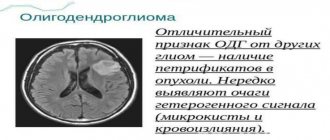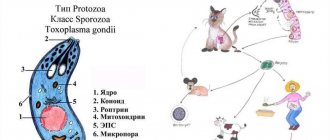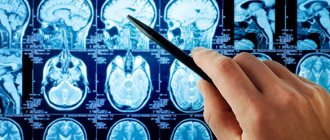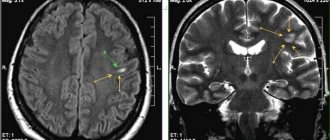Lacunar stroke is a disease that affects not only older people. Today it can be diagnosed in young people and even children. Let's consider the causes and features of the pathology, methods of diagnosis, therapy and rehabilitation, as well as what to do for patients who have suffered a lacunar stroke.
Lacunar stroke is one of the types of ischemic brain damage (IM). The disease occurs as a result of impaired blood flow in small arteries located in the trunk and deep parts of the hemispheres of the brain.
The pathology in most patients is asymptomatic, since the area of damage to the nervous tissue is limited. As a rule, its dimensions do not exceed 1.5-2 cm in diameter.
A single lacunar ischemic stroke has a favorable prognosis. Repeated circulatory disorders are accompanied by changes in the patient's mental status. The consequences of the pathology are vascular dementia, deep depression, parkinsonism. The prognosis for such patients is guarded.
Features of lacunar stroke
The term “lacuna” owes its origin to the French physician Maxime Durand-Fardel, who first used it in his scientific treatise on the pathoanatomical features of the brain. He noticed that some patients had small cavities in the cortex and brain stem, each of which had a blood vessel leading to it. The scientist suggested that this is the result of an inflammatory process.
Subsequently, this topic was actively developed: the “lacunary hypothesis” was formulated. She linked ischemic damage to the brain with arterial hypertension and atherosclerotic changes in the walls of blood vessels.
Among the features of the disease are:
- Asymptomatic. Most patients are unaware of the disease.
- Localization. Cavities are most often found in the brainstem and white matter.
- Age. The pathology can affect people of working age and even children, but the largest percentage of patients are pensioners.
FAN Help
World Stroke Day was established in 2006. The purpose of this initiative was to call on all countries to take urgent and proactive action in the fight against this disease.
Today, stroke and other cardiovascular diseases remain one of the main causes of death and disability throughout the world, including in Russia. At the same time, in our country the mortality rate from stroke is one of the highest in the world.
According to WHO, 6.7 million people die from stroke every year in the world, and, as experts note, about a third of deaths occur in people of working age 30–40 years.
Causes of lacunar stroke
The main causes of the pathology are high blood pressure and atherosclerotic changes in the blood vessels. Experts note that the disease can develop both at the height of an arterial crisis and during a stable course of hypertension.
In addition, significant etiological factors:
- congenital anomalies of cerebral vessels;
- emboli resulting from myocardial infarction;
- endocrine pathology;
- conditions associated with increased thrombus formation;
- bad habits.
Symptoms of lacunar tonsillitis
Signs of lacunar angina include general symptoms of intoxication and local inflammation of lymph tissue.
Upon examination, inflammation is visualized on both sides; one tonsil on one side is rarely inflamed. The clinical picture of lacunar tonsillitis is as follows:
- Sore throat.
- Pain when swallowing, talking and eating. At rest, pain does not bother the patient.
- Decreased appetite.
- Fatigue, lethargy, general malaise.
- Chills and fever due to elevated temperature. The temperature reaches 40° and lasts up to six days.
Specific symptoms include:
- Accumulation of purulent plugs of yellowish color. First, a yellowish-white coating appears around the tonsils, which is easily removed. Gradually it develops into a dense film, and it turns into purulent deposits if treatment is not started on time. Pus fills all the space in the recesses of the tonsils and surrounds them.
- Lumps under the lower jaw in the neck area.
- Bad breath.
- Enlargement of regional lymph nodes.
- Difficulty swallowing food. Swallowing disorder is associated with a strong increase in the size of the tonsils, which causes the digestive tube to narrow.
Signs of lacunar stroke
Symptoms of lacunar ischemic brain injury occur in approximately 20 percent of patients. In most patients, the disease has no clinical manifestations and is often an incidental diagnostic finding during tomography.
Symptoms of the disease are combined into symptom complexes or syndromes. Neurologists identify about 20 syndromes, the most common of which are:
- Isolated motor syndrome. It occurs in 6 out of 10 patients with lacunar stroke. Patients complain of limited mobility in the limbs and impaired facial expressions. Symptoms are most often unilateral, they occur on the side opposite to the ischemic lesion.
- Isolated sensitive syndrome. With this variant of the course, the patient is impaired in all types of sensitivity. The patient ceases to recognize temperature, pain, tactile and other stimuli. Sensitivity disappears completely or is partially reduced.
- Atactic hemiplegic syndrome. Such symptoms are diagnosed in 10-12% of patients. It is characterized by weakness in the legs or arms combined with impaired motor activity on the affected side.
In addition, symptoms of the disease include:
- disturbance of urination and defecation;
- memory impairment;
- slurred speech.
If any neurological symptoms appear, you should immediately seek specialized help. Early initiation of treatment will improve the patient's condition and prevent the development of relapses.
Symptoms of lacunar tonsillitis in children
The signs of a sore throat in a child are the same as in adults, only they appear more acutely. The disease progresses rapidly, because The child’s immunity is not fully formed and the defenses cannot resist infection.
Already from the first day, the temperature rises to 40-40.5 ° C, against this background diarrhea and vomiting appear. Some parents believe that there is no need to lower the temperature, because the body fights the infection on its own. This statement is completely false. It is important to immediately reduce the temperature if it rises above 38°C, otherwise convulsions may begin.
When caring for a baby, relatives need to respect communication boundaries and wear a medical mask. Fortunately, lacunar tonsillitis in children rarely leads to complications.
Often this disease in children is treated in a hospital setting. If the condition worsens within 3-4 days, the child is hospitalized. In the hospital, instrumental washing of the tonsils, droppers, intravenous and intramuscular injections quickly improve the baby’s condition.
Diagnostic methods
Diagnosis of lacunar stroke is a complex process. The area with pathological changes is small in size, so even modern imaging techniques are not always able to determine it. Only an integrated approach to diagnostics allows a correct diagnosis to be made. Experts take into account:
- Anamnesis. A patient with suspected lacunar stroke has a history of arterial hypertension, metabolic disorders, and other risk factors.
- Patient's complaints. This is a basic component of any diagnosis.
- Clinical picture. Symptoms of the disease may appear immediately in full or increase gradually, so the patient should be monitored over time.
- Biochemical blood parameters (increased cholesterol, some fractions of lipoproteins, blood glucose).
- An electrocardiogram, which can detect abnormal heart rhythms and symptoms of myocardial infarction.
- MRI. This instrumental method allows one to visualize cavities in brain tissue at different levels and determine their shape and size.
Diagnosis of cerebral hemorrhage and tests
Despite the fact that a person without medical education can pre-determine a stroke and report it to the doctor and ambulance, a final diagnosis can only be made after a full examination of the patient. Diagnosis of a stroke consists of several stages:
- Anamnesis collection,
- Physical examination: tests that may reveal early signs of a stroke,
- Laboratory diagnostics: blood test to determine the level of inflammatory proteins, glucose, lipids;
- Hardware diagnostics: CT, MRI, diffusion-weighted tomography, DWI, magnetic resonance imaging, cerebral angiography, Doppler ultrasound.
Basic principles of treatment
Timely treatment can significantly improve the prognosis without leading the pathology to serious consequences. One of the main points in therapy is the correction of blood pressure. It is achieved through:
- good rest;
- reducing the number of stressful situations;
- giving up bad habits;
- normalization of diet;
- taking antihypertensive medications.
Normalization of blood pressure levels should be combined with the use of antiplatelet agents. They improve the rheological properties of blood and prevent the development of relapses.
Another direction of treatment for patients with lacunar ischemic stroke is the use of medications that improve blood microcirculation. Therapy begins parenterally with a gradual transition to oral administration.
To improve the condition of nervous tissue, neurotrophics are used. They improve the supply of oxygen and nutrients to the GM, stimulating restoration processes.
Classification of stroke types
Types of stroke according to the mechanism of circulatory disorders:
- Ischemic stroke,
- Hemorrhagic stroke,
- Subarachnoid stroke.
Stroke is classified according to severity:
- Micro stroke,
- Mild to moderate stroke
- Severe stroke.
IgG antibodies to coronavirus COVID-19 in Moscow from 2 days
from 700 ₽
Sign up
Total IgM and IgG antibodies to coronavirus COVID-19 in Moscow from day 1
from 900 ₽
Sign up
Rehabilitation after stroke
The consequences of lacunar stroke include both motor and psychological disorders, so the rehabilitation of such patients must be comprehensive. It needs to start as early as possible and be carried out under the supervision of a specialist.
Motor rehabilitation is aimed at eliminating negative consequences from the musculoskeletal system. Its goal is to restore full range of motion. For this use:
- special physical exercises;
- electrical stimulation of the neuromuscular system;
- passive gymnastics;
- training on simulators.
The prognosis for early initiation of motor rehabilitation is positive. In most patients, the amount of motor activity in the affected limb increases.
Speech impairment is a common consequence of lacunar stroke. For the rehabilitation of such patients:
- conduct classes with a speech therapist;
- communicate with family.
The absence of speech isolation is the most important factor for positive rehabilitation. It significantly improves the prognosis and increases the likelihood of restoration of speech understanding and production.
Social rehabilitation is achieved by creating a favorable microclimate in the family, gradually involving the patient in household chores, and interesting hobbies.
Consequences
The prognosis depends entirely on whether the stroke is isolated. If yes, then the likelihood of a full recovery after rehabilitation is very high. Sometimes a recovered person may still have minor symptoms even after a long recovery, but this is very rare.
In the presence of several foci of lacunar infarction, the prognosis is somewhat worse. Such patients are faced with lacunar disease of the brain, in which a person develops atherosclerosis, combined with thrombosis and damage to many arteries. In this case, recovery is much more difficult.
The main problem that worsens any prognosis is the person’s mental state. A lacunar-type stroke has a strong negative impact on the entire psyche, which is why it undergoes noticeable changes. A person develops memory lapses, finds it difficult to navigate in space, communicate with other people, and is constantly nervous and upset.
The consequence of a lacunar stroke for many patients is disability, which prevents them from working fully. However, with proper rehabilitation, there is every chance of returning to normal life, as well as eliminating the risk of relapse.
Rehabilitation
In cases of mild cerebral infarction, the recovery period takes about three weeks, but in more severe conditions it may take several months to achieve a full recovery, if possible. Rehabilitation includes revising your lifestyle and attending special procedures aimed at improving the general condition of the body.
Anyone recovering from a lacunar stroke will need:
- Adjust your diet. Fatty foods, sweets, coffee, alcohol, as well as all foods that can increase blood pressure or trigger the return of the underlying cause of the stroke should be excluded from the diet.
- Spend enough time outdoors and move. Those who feel unwell can simply walk around the apartment or perform the simplest exercises possible with the windows open.
- Rest. It is important not only to avoid excessive mental stress, but also to sleep well. Proper rest eliminates the development of many complications and also reduces the risk of relapse.
- Do exercise therapy. Therapeutic exercises will help you quickly regain motor functions and improve the condition of muscle tissue, restoring their tone.
- Attend a massage. A high-quality head and whole body massage helps normalize physical and psychological well-being. With regular procedures, a person will feel a significant effect within a couple of weeks.
Rehabilitation is the most important component of treatment that should be considered. It allows you to regain your health as quickly as possible.
Possible complications
In cases where lacunar infarction occurs in a fairly mild form, the risk of complications is minimal. Nevertheless, it is there. And with a stroke that has several foci at once, complications almost always appear.
What can the patient expect:
- Motor skills disorders;
- Problems with orientation in space;
- Decreased intellectual abilities;
- Memory losses;
- Inflammation of nerve tissue;
- Tingling of the limbs;
- Problems with urination;
- Partial or complete loss of speech abilities;
- Death.
In the absence of the necessary treatment, a person can quickly develop any complication, which will soon lead to death, because It is impossible to survive after a stroke without medical intervention.
If your health worsens during the recovery period, you should definitely contact your doctor.
What to do to prevent lacunar stroke?
The basis of disease prevention is lifestyle changes. It includes:
- sufficient physical activity;
- inclusion of a large amount of vegetables and fruits in the diet;
- quitting smoking and alcohol.
It is also important to control blood pressure, blood sugar, and cholesterol levels. For patients with a history of ischemic pathology of the brain, periodic examination by a neurologist is recommended.








